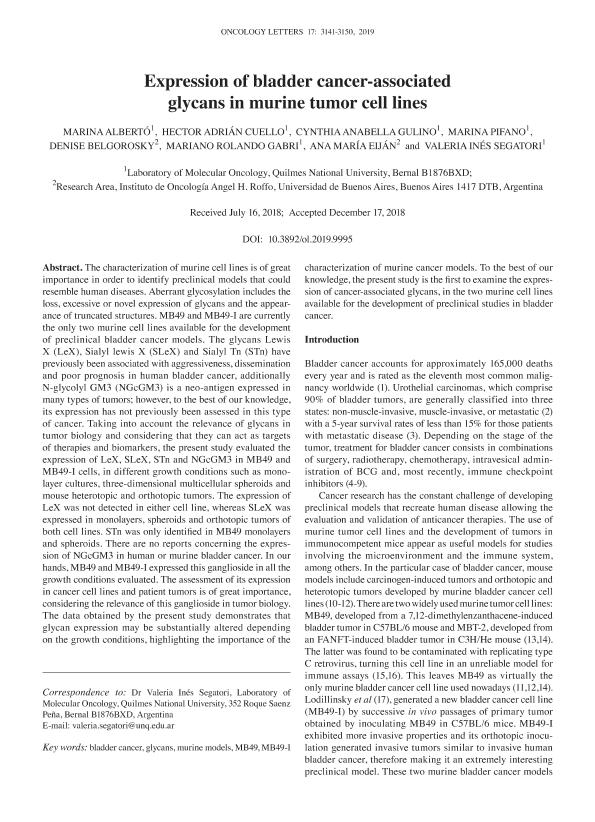Mostrar el registro sencillo del ítem
dc.contributor.author
Alberto, Marina

dc.contributor.author
Cuello, Héctor Adrián

dc.contributor.author
Gulino, Cynthia Antonella

dc.contributor.author
Pifano, Marina

dc.contributor.author
Belgorosky, Denise

dc.contributor.author
Gabri, Mariano
dc.contributor.author
Eijan, Ana Maria

dc.contributor.author
Segatori, Valeria Inés

dc.date.available
2021-06-07T13:53:54Z
dc.date.issued
2019-03
dc.identifier.citation
Alberto, Marina; Cuello, Héctor Adrián; Gulino, Cynthia Antonella; Pifano, Marina; Belgorosky, Denise; et al.; Expression of bladder cancer‑associated glycans in murine tumor cell lines; Spandidos Publications; Oncology Letters; 17; 3; 3-2019; 3141-3150
dc.identifier.issn
1792-1082
dc.identifier.uri
http://hdl.handle.net/11336/133321
dc.description.abstract
The characterization of murine cell lines is of great importance in order to identify preclinical models that could resemble human diseases. Aberrant glycosylation includes the loss, excessive or novel expression of glycans and the appearance of truncated structures. MB49 and MB49-I are currently the only two murine cell lines available for the development of preclinical bladder cancer models. The glycans Lewis X (LeX), Sialyl lewis X (SLeX) and Sialyl Tn (STn) have previously been associated with aggressiveness, dissemination and poor prognosis in human bladder cancer, additionally N-glycolyl GM3 (NGcGM3) is a neo-antigen expressed in many types of tumors; however, to the best of our knowledge, its expression has not previously been assessed in this type of cancer. Taking into account the relevance of glycans in tumor biology and considering that they can act as targets of therapies and biomarkers, the present study evaluated the expression of LeX, SLeX, STn and NGcGM3 in MB49 and MB49-I cells, in different growth conditions such as mono-layer cultures, three-dimensional multicellular spheroids and mouse heterotopic and orthotopic tumors. The expression of LeX was not detected in either cell line, whereas SLeX was expressed in monolayers, spheroids and orthotopic tumors of both cell lines. STn was only identified in MB49 monolayers and spheroids. There are no reports concerning the expression of NGcGM3 in human or murine bladder cancer. In our hands, MB49 and MB49-I expressed this ganglioside in all the growth conditions evaluated. The assessment of its expression in cancer cell lines and patient tumors is of great importance, considering the relevance of this ganglioside in tumor biology. The data obtained by the present study demonstrates that glycan expression may be substantially altered depending on the growth conditions, highlighting the importance of the characterization of murine cancer models. To the best of our knowledge, the present study is the first to examine the expression of cancer-associated glycans, in the two murine cell lines available for the development of preclinical studies in bladder cancer.
dc.format
application/pdf
dc.language.iso
eng
dc.publisher
Spandidos Publications

dc.rights
info:eu-repo/semantics/openAccess
dc.rights.uri
https://creativecommons.org/licenses/by-nc-sa/2.5/ar/
dc.subject
BLADDER CANCER
dc.subject
GLYCANS
dc.subject
MB49
dc.subject
MB49-I
dc.subject
MURINE MODELS
dc.subject.classification
Otras Ciencias de la Salud

dc.subject.classification
Ciencias de la Salud

dc.subject.classification
CIENCIAS MÉDICAS Y DE LA SALUD

dc.title
Expression of bladder cancer‑associated glycans in murine tumor cell lines
dc.type
info:eu-repo/semantics/article
dc.type
info:ar-repo/semantics/artículo
dc.type
info:eu-repo/semantics/publishedVersion
dc.date.updated
2020-11-09T19:28:00Z
dc.journal.volume
17
dc.journal.number
3
dc.journal.pagination
3141-3150
dc.journal.pais
Grecia

dc.journal.ciudad
Atenas
dc.description.fil
Fil: Alberto, Marina. Consejo Nacional de Investigaciones Científicas y Técnicas; Argentina. Universidad Nacional de Quilmes. Departamento de Ciencia y Tecnología. Laboratorio de Oncología Molecular; Argentina
dc.description.fil
Fil: Cuello, Héctor Adrián. Consejo Nacional de Investigaciones Científicas y Técnicas; Argentina. Universidad Nacional de Quilmes. Departamento de Ciencia y Tecnología. Laboratorio de Oncología Molecular; Argentina
dc.description.fil
Fil: Gulino, Cynthia Antonella. Universidad Nacional de Quilmes. Departamento de Ciencia y Tecnología. Laboratorio de Oncología Molecular; Argentina
dc.description.fil
Fil: Pifano, Marina. Universidad Nacional de Quilmes. Departamento de Ciencia y Tecnología. Laboratorio de Oncología Molecular; Argentina. Consejo Nacional de Investigaciones Científicas y Técnicas; Argentina
dc.description.fil
Fil: Belgorosky, Denise. Consejo Nacional de Investigaciones Científicas y Técnicas. Oficina de Coordinación Administrativa Houssay; Argentina. Universidad de Buenos Aires. Facultad de Medicina. Instituto de Oncología; Argentina
dc.description.fil
Fil: Gabri, Mariano. Universidad Nacional de Quilmes. Departamento de Ciencia y Tecnología. Laboratorio de Oncología Molecular; Argentina
dc.description.fil
Fil: Eijan, Ana Maria. Universidad de Buenos Aires. Facultad de Medicina. Instituto de Oncología "Ángel H. Roffo"; Argentina. Consejo Nacional de Investigaciones Científicas y Técnicas. Oficina de Coordinación Administrativa Houssay; Argentina
dc.description.fil
Fil: Segatori, Valeria Inés. Universidad Nacional de Quilmes. Departamento de Ciencia y Tecnología. Laboratorio de Oncología Molecular; Argentina. Consejo Nacional de Investigaciones Científicas y Técnicas. Oficina de Coordinación Administrativa Houssay; Argentina
dc.journal.title
Oncology Letters
dc.relation.alternativeid
info:eu-repo/semantics/altIdentifier/url/http://www.spandidos-publications.com/10.3892/ol.2019.9995
dc.relation.alternativeid
info:eu-repo/semantics/altIdentifier/doi/http://dx.doi.org/10.3892/ol.2019.9995
Archivos asociados
